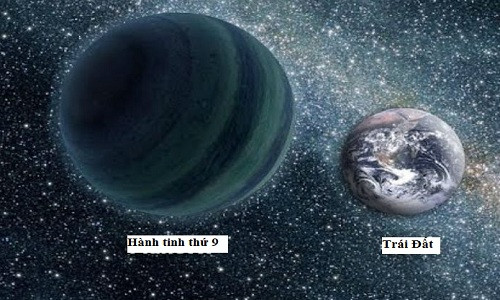The Sun hypothesis steals the ninth planet from another star
The ninth planet also hidden at the edge of the solar system may belong to another star who passed by a long time ago.
In January 2016, two researchers Konstantin Batygin and Michael Brown published evidence that an unobserved planet 10 times the Earth is hiding at the outer edge of the solar system. Other astronomers immediately proposed many theories about how the ninth planet or X planet moves from the inner rim to the outer ring of the system, according to New Scientist.
However, another research group proposed the planet X hypothesis to be retained from the neighbor star. This hypothesis is likely to occur. The Sun was born in a large star cluster of about 1,000-10,000 stars, according to Alexander Mustill at Lund Observatory, Sweden. In such a dense cluster of stars, the Sun may experience several times to approach other stars and swap planets with them.
"The Sun hypothesis captures planets of other stellar systems and carries them along throughout the route, which is hard to believe," said Greg Laughlin of Lick Observatory, California, USA.

The 9th planet is 10 times larger than Earth's mass.(Photo: NASA).
To test the hypothesis, Mustill and his colleagues simulated the solar system encounters with the passing planetary system. They found that if a system with a planet orbits a wide orbit, it is likely to be retained by the Sun at 50%.
Although the ratio is quite high, the hypothesis becomes less certain when the team considers whether a passing star system has a wide orbiting planet. Simulations are also true only when the planet is retained exactly like planet X. Mustill and his colleagues believe that the probability of planet X originating outside the solar system is in the range of 0.1-2%.
"Although the numbers seem low, you need to compare abilities with each other. Because after all, every specific case is uncertain , " Mustill said.
The chance of planet X actually exists only 0.007% at the present time, so the possibility of it being an extrasolar planet is 15-300 times higher.
At first, Batygin and Brown argued that the planet X is likely to be the core of a giant gas planet that was ejected from the rim of the solar system while the system was forming at the beginning."My hypothesis is that the event happened very early and there was a lot of gas around the nebula, causing the core to slow down and not be completely released from the solar system," Brown said.
The last hypothesis is that planet X formed in today's position. Although some researchers speculate that there is not enough material to form planets on the outer solar system, Scott Kenyon of the Smithsonian Center for Astrophysics - Massachusetts, USA, discovered the amount of gravel 200 million years ago. The year is enough to form a small planet like planet X. "I think it's too early to conclude which theory is most certain," Kenyon said.
- Uranus - The most exotic planet in the Solar System
- Fluttering new evidence of the existence of the 9th planet
- Planet's 'carnivorous' star is 450 light years from Earth
- Planet 'monsters' should not exist according to astronomical theory
- Star 'grilled' child planet
- Find the most 'lonely and poor' planet in the universe
- The truth about why light is reduced by aliens
- The conceived planet is still attached to the star mother belt
- Detecting Goblin dwarf planet redefines the Solar System
- Billard game of giant planets
- The giant planet forms around the star near the Earth
- Star swallow the planet
 Van Allen's belt and evidence that the Apollo 11 mission to the Moon was myth
Van Allen's belt and evidence that the Apollo 11 mission to the Moon was myth The levels of civilization in the universe (Kardashev scale)
The levels of civilization in the universe (Kardashev scale) Today Mars, the sun and the Earth are aligned
Today Mars, the sun and the Earth are aligned The Amazon owner announced a secret plan to build a space base for thousands of people
The Amazon owner announced a secret plan to build a space base for thousands of people